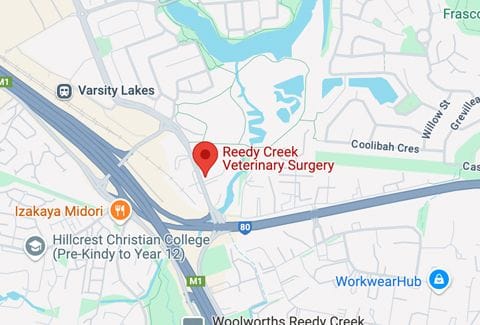Intestinal Worm Symptoms & Treatment in Dogs
)
Because of prevention, intestinal worms aren’t as common as they used to be. But, unfortunately, they’re still here on the Gold Coast and pet owners should remain vigilant.
The most common types of intestinal worms on the Gold Coast
There are four prevalent types of worms found in dogs in our city that veterinarians are prepared for.
Whipworms
Whipworms are less common compared to other intestinal parasites listed in this guide. But, Gold Coast pet owners should remain alert for the symptoms and warning signs because whipworms have the highest risk of carrying diseases.
How to spot whipworms in dogs
Whipworms are small and are shaped as their names suggest (thick at the front with a long tail end). They are rarely easy to spot with the naked eye, usually only growing up to 6mm in length.
Pets affected by whipworms might:
Start losing large amounts of weight suddenly or unusually
Have upset stomachs and irregular bowel movements (diarrhoea, excessive toileting)
Have blood or mucus in their droppings
How dogs can get whipworms
Whipworms can only be contracted when their eggs are digested by unsuspecting hosts. In a dog’s case, whipworm eggs are commonly ingested when our pets get too close to another animal’s dropping when sniffing or if they try to eat it.
A whipworm infestation can take 10 to 60 days to start after ingesting eggs.
Roundworms
Easier to spot compared to whipworms, roundworms are more common and easier to learn the warning signs of.
How to spot roundworms in dogs
Roundworms are different in that they are visible to the naked eye and can be spotted in affected pet droppings. In some cases, animals can even cough or vomit up parts of roundworms.
They are a rounded shape and can grow as long as 9 to 18cm in length.
Pets affected by roundworms may:
Experience sudden and unexpected weight loss
Experience irregular bowel movements like excessive toileting and diarrhoea
Be less energetic (lethargic)
Have a noticeable change in fur colour or feeling (become duller and lose softness)
Have bloated stomachs or abdomens
How dogs get roundworms
Similar to whipworms, a dog may unknowingly ingest roundworm eggs when getting too close to an infected animal’s droppings.
Roundworm eggs can also be carried in common critters around homes like insects, mice, and cockroaches.
Hookworms
Hookworms are one of the rarer types of intestinal parasites on the Gold Coast, but they still pose a notable risk to dogs of all ages (particularly those that are young and developing).
How to spot hookworms in dogs
A dog affected by hookworms will be more difficult to identify compared to pets affected by other intestinal parasites, as a fully-grown hookworm often only grows to 2 to 3mm in length.
A dog affected by hookworms may:
Have diarrhoea (often accompanied by blood in stool)
Be weak and less energetic
Show discolouration in their coat
Become anemic (indicated by a change of gum colour)
How dogs get hookworms
Despite being less common, hookworms are transmitted through a wider range of possibilities. Their eggs can still be contracted through ingestion (commonly through infected pet droppings), and they can also be transmitted by the larvae penetrating your pet’s skin and then migrating to the intestines. A dog walking or playing where hookworm eggs have been dropped could be at risk of contraction.
Hookworms can also be transmitted through a puppy’s mother in utero, or after they’ve been born, through the mother’s milk.
Tapeworms
Tapeworms are unique, both in how infections start and their appearance. Like other parasites, they pose a greater risk to younger, developing pets.
How to spot tapeworms in dogs
Tapeworms affecting dogs can grow to a notable 30 cm in length and are made of flat, segmented parts. Often diagnosed from the well known “scooting” behaviour a dog might engage in, tapeworms cause discomfort and agitation (usually at our pet’s rear ends).
As well as scooting, a dog affected by tapeworms might:
Be itchy and scratch themselves excessively
Try chewing and licking at their rear end
How dogs get tapeworms
Tapeworms must be contracted through an intermediate host. That means that, unlike other worm eggs on this list, tapeworm eggs are usually carried in pests that are attracted to dogs (like fleas).
An egg-carrying flea or another intermediate host (and the eggs) may be ingested by a dog as it tries to itch or scratch at it, leading to tapeworm infection.
Tips to treat and prevent worms in dogs
Preventing worms
Pets as young as two to three weeks can have vet-approved treatments to help prevent the risk of parasitic worms in dogs. Your veterinary expert can also recommend medications that kill parasitic worms such as hookworms, whipworms and tapeworms.
Depending on the recommendation for your pet, plus the advice of your vet, your pet may require treatment between one and three months. Variables such as age, breed, weight, and lifestyle may affect treatment and prevention advice.
Treating parasitic worms
If you think your dog may have a parasitic infection from an intestinal worm on this list (or unlisted), contact us or make a booking online.
Parasitic infections can lead to further health implications. In puppies, severe parasitic infections can even be fatal; treatment of parasitic worms can be as simple as feeding your pet an oral deworming tablet.
Contact Reedy Creek Vet to make a booking with a veterinarian for diagnosis, treatment advice, and further recommendations.
Our veterinary surgery is open Mondays to Fridays from 8 am in the morning until 5:30 pm in the evening. Our clinic is also open from 8 am to 12 pm on Saturdays.
Call our vet surgery at (07) 5593 8395.
| Tags:DogClient InformationHealth AdviceProactive Pet Care |
&geometry(140x140))

